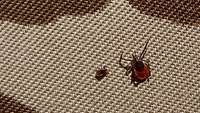Vector control – protection against pathogenic agents
Vector control – protection against pathogenic agents
- Date:
- Place:
- Erding
- Reading time:
- 3 MIN
On operational deployments and during training exercises, our troops are exposed to many dangers. One of these is almost invisible and comes from what is called vectors. Vectors are insects, ticks and mites, which can transmit pathogenic agents that may cause life-threatening diseases. Lasting protection is provided by permanent vector-protective coating.
As part of the major organisational element "equipment, information technology and in-service support", one of the major fields of expertise of the Bundeswehr Research Institute for Materials, Fuels and Lubricants (Wehrwissenschaftliches Institut für Werk- und Betriebsstoffe, WIWeBWehrwissenschaftliches Institut für Werk- und Betriebsstoffe) in Erding is the development of such protective technologies.
Built into the clothing
To prevent infections caused by vectors of disease such as mosquitos or ticks during operations abroad or exercises in wooded areas, combat clothing has a vector-protective coating that offers lasting protection.
This protective coating consists of active substances that are directly applied to the uniform fabric together with the camouflage print during the production process.
The vector-protective coating remains effective throughout the entire life cycle of the clothes. It is not necessary to re-impregnate the uniforms; this could, by contrast, even destroy the coating. However, certain care instructions must be followed for this type of clothing. To ensure that these are complied with, the uniforms are cleaned by contract laundries.
How does vector protection work?
The active substance is the tried and tested biocide permethrin, a contact poison for insects and arachnids.
The poison is released gradually from depots. The depot effect is generated by a synthetic layer on the textile fibres of the fabric in which a certain amount of the active substance permethrin is stored. Permethrin can move within the synthetic matrix and thus comes to the surface to restore the coating after each wash cycle or if required. This ensures particularly long-lasting and strong vector protection.
Safer to wear
Since comparatively little amounts of permethrin are absorbed on the surface, the Bundeswehr method is much safer for the wearers of the uniforms than previous dip coating or spraying processes.
For the same reason, the effect on the human organism is much smaller than if the fabric is impregnated after production. This positive side effect was confirmed by the results of blood and urine tests made during occupational health examinations in cooperation with the Federal Institute for Risk Assessment (Bundesinstitut für Risikobewertung). Such tests had been common practice to rule out health hazards for uniform wearers even before vector-protective coating was introduced.
How is efficacy checked?
To verify the coating's efficacy against vectors, it must first be ensured that a defined minimum effect is reached. To this end, the WIWeBWehrwissenschaftliches Institut für Werk- und Betriebsstoffe follows an elaborate approval procedure during which not only the active substance content is checked, but also its biological activity, i.e. the effect the active substance has on the vectors.
If these requirements are met, the fabric is subjected to 100 wash cycles in the laboratory to determine whether the remaining protection level is still sufficient. This process is intended to simulate the entire life cycle of such textiles. Only if this test phase, too, has been completed successfully, can the clothing be approved and put into use.
Protection with benefits
The use of these new technologies can prevent infections and disease-related absence of soldiers, improve the operational readiness of the armed forces and enhance wearer safety.
The Bundeswehr ranges among the world’s leading developers of vector protection on textiles and by using this technology incurs no additional costs for the impregnation of clothing.
By now, this kind of vector-protective coating has been adopted by many other NATONorth Atlantic Treaty Organization members.




